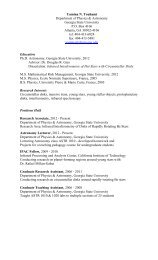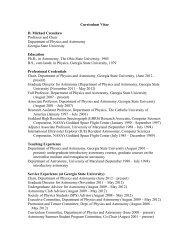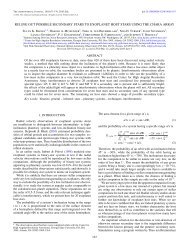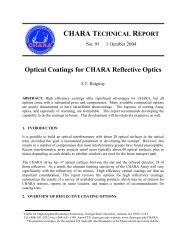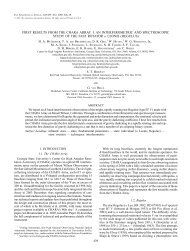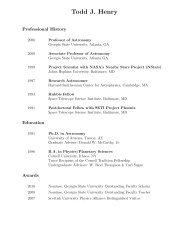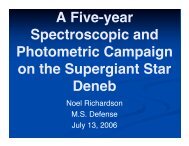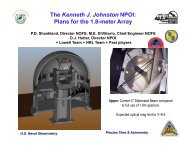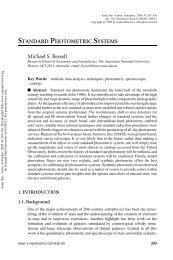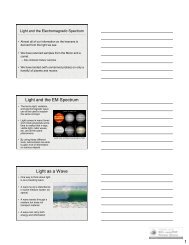the solar neighborhood. ix. hubble space telescope detections of ...
the solar neighborhood. ix. hubble space telescope detections of ...
the solar neighborhood. ix. hubble space telescope detections of ...
Create successful ePaper yourself
Turn your PDF publications into a flip-book with our unique Google optimized e-Paper software.
1738 GOLIMOWSKI ET AL.<br />
Vol. 128<br />
Fig. 2.—Reduced and calibrated NIC2 images <strong>of</strong> <strong>the</strong> binary M dwarf GJ 84AB. Each panel shows <strong>the</strong> full NIC2 FOV (19B5 ; 19B5) with logarithmic p<strong>ix</strong>el scaling.<br />
The saturated core <strong>of</strong> <strong>the</strong> F110W image is marked with black p<strong>ix</strong>els. The o<strong>the</strong>r black p<strong>ix</strong>els denote intrinsically bad p<strong>ix</strong>els and p<strong>ix</strong>els affected by instrumental debris<br />
(‘‘grot’’) that has settled on <strong>the</strong> detector. The diffuse disks in <strong>the</strong> upper left quadrants <strong>of</strong> <strong>the</strong> images are flat-field artifacts caused by NIC2’s coronagraphic hole. The<br />
M7 V companion (marked ‘‘B’’ in <strong>the</strong> top left panel ), which lies 0B44 from <strong>the</strong> primary star along <strong>the</strong> sou<strong>the</strong>ast diffraction spike, is barely seen amid <strong>the</strong> highly<br />
structured PSF <strong>of</strong> <strong>the</strong> primary star.<br />
ARC 3.5 m <strong>telescope</strong> and <strong>the</strong> Seaver Prototype Imaging<br />
Camera (SPICam), which features a 2048 ; 2048 p<strong>ix</strong>el CCD<br />
with an unbinned image scale <strong>of</strong> 0B141 p<strong>ix</strong>el 1 . Exposures<br />
<strong>of</strong> 1, 10, and 60 s were recorded using <strong>the</strong> Sloan Digital Sky<br />
Survey (SDSS) z filter and 2 ; 2 p<strong>ix</strong>el binning. The 1 s image<br />
<strong>of</strong> G239-25A was unsaturated and indicated a seeing-limited<br />
image resolution <strong>of</strong> 1B25. The sky transparency was variable,<br />
so no photometric calibration was possible. The images were<br />
reduced conventionally by subtracting <strong>the</strong> electronic bias and<br />
dividing by a flat-field image.<br />
Figure 6 shows a 14B4 ; 14B4 section <strong>of</strong> <strong>the</strong> reduced 1 s<br />
image centered on G239-25A. Part <strong>of</strong> <strong>the</strong> star’s seeing-limited<br />
PSF has been subtracted to reveal G239-25B more clearly.<br />
(Lacking a comparably exposed reference star, we subtracted<br />
artificial background values that were interpolated from radial<br />
pr<strong>of</strong>iles <strong>of</strong> <strong>the</strong> PSF at azimuths 45 from <strong>the</strong> position angle<br />
[P.A.] <strong>of</strong> G239-25B.) The companion is located 2B84 0B14<br />
from G239-25A at P:A: ¼ 106N5 3N6. The errors in <strong>the</strong>se<br />
values include a 0.5 p<strong>ix</strong>el uncertainty in each coordinate <strong>of</strong><br />
G239-25B’s centroid and a possible 0N4 errorin<strong>the</strong>alignment<br />
<strong>of</strong> SPICam’s detector with <strong>the</strong> celestial axes (R. McMillan<br />
2004, private communication). The integrated signals <strong>of</strong> each<br />
star within circular apertures <strong>of</strong> radius 0B85 (3 p<strong>ix</strong>els) indicate<br />
a magnitude difference <strong>of</strong> z 4:9.<br />
2.2.3. GJ 1001ABC<br />
A follow-up observation <strong>of</strong> <strong>the</strong> GJ 1001 triple system was<br />
performed on 2003 August 20 using <strong>the</strong> High Resolution<br />
Channel (HRC) <strong>of</strong> <strong>the</strong> HST ACS (Ford et al. 2003; Pavlovsky<br />
et al. 2003). 11 The HRC features a 1024 ; 1024 p<strong>ix</strong>el CCD<br />
with a p<strong>ix</strong>el scale <strong>of</strong> 0B025 ; 0B028. Its 26 00 ; 29 00 FOV<br />
11 This observation was conducted as part <strong>of</strong> <strong>the</strong> guaranteed observing time<br />
awarded to <strong>the</strong> ACS Investigation Definition Team.



